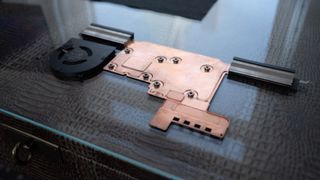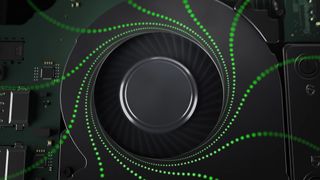
The new Razer Blade is, hands down, the most impressive and comprehensive redesign we’ve ever seen on a laptop. From the narrower bezels, sleeker design, upgraded components, to the new keyboard and trackpad, nearly every part of this gaming notebook has been retouched.
Razer told us plenty about the first redesign for its flagship gaming laptop, but we wanted to dig even deeper into the nitty gritty of how this impressive overhaul came to be. Luckily, we caught up with Luca Di Fiore, Director of Research and Development and Jesse Recinos who was Project Manager for the development of the Razer Blade, to get the inside scoop.
Recinos explains the Razer Blade redesign only happened now because “essentially, the rest of the world caught up to what our vision of a portable, slim, attractive gaming notebook looked like.”
“The Blade has always eschewed the size and the portability of a normal gaming notebook and to get there, we always had to make tough decisions about screen size and components,” Recinos says. “But choosing 14-inch versus 15-inch for example, we know that we gave up some of the options that people wanted, like having a high refresh rate, etc.”
“Basically, with the next generation components, we could actually maintain the two out of the three of the Blade’s original dimensions and grow the thing to accommodate the additional width of a 15-inch panel,” Recinos explains. “It kind of became a no-brainer at that point.”




Millimeter wave
Di Fiore jumps in to note that the biggest driving force for the team was reducing as much as possible, shaving off every single point of millimeter that we could from the new Blade.
“The engineering team really found solutions for every single point of a millimeter that we could shave off of the device, Di Fiore expounds. “That has been a relentless, and utterly painful to a certain point, process of really trying to figure out how do we make the smallest possible package with the maximum amount of performance.”
Get daily insight, inspiration and deals in your inbox
Sign up for breaking news, reviews, opinion, top tech deals, and more.
This almost obsessive passion for thinness and performance is exactly what lead to the development of a new cooling system that gets rid of heat pipes for an entirely vapor chamber chilled system.
“We thought ‘hey, wait a minute, if we don't use the flattened down heat pipes, maybe we can shave off 0.2 millimeters.” Di Fiore recalls. “OK, so we gained 0.2 millimeters here, so now how do we, for instance, grow the battery.”

Although the vapor chamber might look like nothing more than a single sheet of copper, it’s a far more intricate piece of technology. Vapor chamber fabrication involves creating an internal wing structure that needs to be very precise to the amount of the water vapor. This specific type of liquid in turn travels back and forth through this complex wing structure to absorb heat from the components.
The thing about this vapor chamber cooling is its usually backed up by heat pipes to help carry the said heat away to heat sinks and fans.
“Everybody in the thermal industry can actually produce the thin fins,” Di Fiore says. “Nobody ever has done the structural vapor chamber that also does the heat exchange through the fins. So, there were a lot of challenges that the thermal engineering team resolved, and I think they actually pulled off astonishing work.”

Another challenge for Di Fiore and Recinos was creating a minimally thin fan design that also maximized performance at the same time and minimized acoustics.
“In normal gaming laptops, you have 20 millimeters of fans that you can push things out with, but for us, we are reducing the Z-height as much as possible, so now you only have six, seven millimeters of fans that you have to push air with.” Di Fiore says. “The more you want to add on the CFM side and the more noise you generate, so balancing it all that out was sort of a miracle honestly.”

Thinning out everything
Of course, the Blade’s overall thickness isn’t the only thing that Di Fiore and Recinos worked on. A much more apparent change with the Razer’s flagship laptop is it has gone from a 14-inch screen to a 15.6-inch screen. Not does it give the machine more than an extra inch of screen real estate, but it also allowed Razer to put in a 144Hz high refresh rate panel. But, beyond those specs on paper, Recinos also tells us it’s also an incredibly thin panel.
“The display panel we are using is actually about 20% thinner than the panel that was originally pitched to us so,” Recinos says. “I think we actually said, ‘that's great but can you make it thinner, narrower bezels and higher refresh rate, but you know, also shave off half a millimeter?’”
Di Fiore also chimes in that they “had to push a lot of the industry for getting higher refresh panels into the thickness that we actually wanted. That was a big challenge, and the thinner you go the reliability is much more difficult to control and the backlight is more difficult to control.”
Recinos continues to say that “I think worked out pretty well, but there are a lot of challenges even just routing cables up alongside the screen. I mean there is a lot of systems out there in gaming and non-gaming that actually put the camera below the screen because of these challenges.”

Di Fiore sighs as he remembers perfecting the Blade’s new keyboard was almost just as, if not more, difficult to tune. Thanks to the reduced overall height of the gaming laptop, Razer decided to cut the amount of key travel on the notebook to the same amount as the Blade Stealth while maintaining the same level of actuation force, or feedback.
“Yeah, we kept a balance between the force actuation of the keys and also with the material of the rubber” Di Fiore explains.”It's a specific type of rubber dome composition and a specific size that’s very, very specific to the type of performance that gamer expect.
“Also because we have to consider that for every detail, the rubber domes really have to pass. We actually have very strict reliability tests, so the amount of strokes that it has to pass has to be on par with some of the desktop keyboards” he says. “We use those strongest requirements, since it’s always expected when you see one of our keyboards.”

Standing the test of time
Di Fiore and Recinos are both incredibly proud of the new Blade and, as with the original design of Razer’s flagship gaming laptop, we can expect this design to stick around for some time.
“We're not just designing for today,” Recinos tells us. “We're not even designing for six months out. We're designing for years out. We tend to have very iconic design language, and we stick with it for few different cycles, as you’ve seen.”
“If you think back to the original Blade 17-inch, our first product, it didn't even have a GTX processor,” he says. “It was a GT and it had a dual-core CPU, and within a couple generations between our own engineering iterations and between the vendors catching up with power performance, we were able to have quad-core and have a GTX processor, and it made a lot of difference.”
Recinos stresses that this current iteration might have been spurred on by new machines with narrow bezels and Max-Q graphics, but it’s design is also fully ready to support what’s going to be available in a few years.
“We have to look to the future too, and getting excited about all that stuff really, I think, gives us the confidence to go forward with these designs,” Recinos says.
Kevin Lee was a former computing reporter at TechRadar. Kevin is now the SEO Updates Editor at IGN based in New York. He handles all of the best of tech buying guides while also dipping his hand in the entertainment and games evergreen content. Kevin has over eight years of experience in the tech and games publications with previous bylines at Polygon, PC World, and more. Outside of work, Kevin is major movie buff of cult and bad films. He also regularly plays flight & space sim and racing games. IRL he's a fan of archery, axe throwing, and board games.












